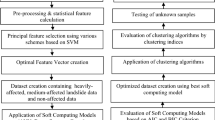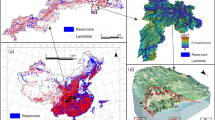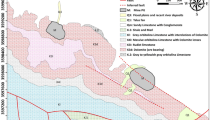Abstract
In Taiwan many reservoirs are constructed in mountain areas. Unfortunately, several earthquakes shook the soil, and typhoons brought a huge amount of water to the reservoir zone. In the past studies, remote-sensing image data were used to effectively monitor the landslide near reservoirs. In recent years, linear discriminant analysis (LDA) has become a well-known method for image classification. However, there are few studies to optimize the linear classification function. While the ancillary information has been adopted easily by new methodologies, the ancillary information must be examined by a landslide image classification system. To explore the effects of optimization on the LDA equations, three approaches were compared: (a) conventional LDA; (b) combined discrete rough sets and LDA (DRS + LDA), which identify the core factors and the corresponding thresholds of landslide occurrence; and (c) combined particle swam optimization algorithm and LDA (PSO + LDA), which optimizes the parameters of LDA equation to attain the best classification outcomes. The above methods were applied to a reservoir region in Taiwan, and the following classification results were obtained. The application of DRS + LDA in our case study reduced the number of ancillary attributes from 14 to 5, and resulted in an accuracy rate of 0.83. On the other hand, the application of PSO + LDA resulted in the same accuracy rate as that of DRS + LDA, whereas the accuracy rate of conventional LDA was found to be 0.78.







Similar content being viewed by others
References
Anbalagan R (1992) Landslide hazard evaluation and zonation mapping in mountainous terrain. Eng Geol 32:269–277
Baeza C, Lantada N, Moya J (2010) Validation and evaluation of two multivariate statistical models for predictive shallow landslide susceptibility mapping of the Eastern Pyrenees (Spain). Environ Earth Sci 61(3):507–523
Barredol JI, Westen CJV (2000) Comparing heuristic landslide hazard assessment techniques using GIS in the Tirajana basin, Gran Canaria and. INT J Appl Earth Obs 2(1):9–23
Choi J, Oh HJ, Won JS, Lee S (2010) Validation of an artificial neural network model for landslide susceptibility mapping. Environ Earth Sci 60(3):473–483
Chou WC, Lin WT, Lin CY (2009) Vegetation recovery patterns assessment at landslides caused by catastrophic earthquake: a case study in central Taiwan. Environ Monit Assess 152(1–4):245–257
Chouchoulas A, Shen Q (2001) Rough set-aided keyword reduction for text categorization. Appl Artif Intell 15(9):843–873
Cruden DM, Varnes DJ (1996) Landslide types and processes. In: Turner AK, Shuster RL (eds) Landslides: investigation and mitigation. Transportation Research Board, National Research Council, Special Report 247. National Academy Press, Washington DC, pp 36–75
Devijver PA, Kittler J (1982) Pattern recognition: a statistical approach. Prentice Hall International
Donati L, Turrini M (2002) An objective method to rank the importance of the factors predisposing to landslides with the GIS methodology: application to an area of the Apennines (Valnerina; Perugia, Italy). Eng Geol 63(3–4):277–289
Friedman JH, Tukey JW (2006) A projection pursuit algorithm for exploratory data analysis. Comput IEEE Trans 23(9):881–890
Fukunaga K (1990) Introduction to Statistical Pattern Recognition. In: Rheinboldt W (ed) Academic Press
Gokceoglu MEC (2002) Assessment of landslide susceptibility for a landslide-prone area (north of Yenice, NW Turkey) by fuzzy approach. Environ Geol 41(6):720–730
Guzzetti F, Carrara A, Cardinali M, Reichenbach P (1999) Landslide hazard evaluation: a review of current techniques and their application in a multi-scale study, Central Italy. Geomorphology 31(1–4):181–216
Huang HP, Yang KC, Lin BW (2012) Statistical evaluation of the effect of earthquake with other related factors on landslide susceptibility: using the watershed area of Shihmen reservoir in Taiwan as a case study. Environ Earth Sci. doi:10.1007/s12665-012-2044-x
Lee S, Min K (2001) Statistical analysis of landslide susceptibility at Yongin, Korea. Environ Geol 40(9):1095–1113
Lee S, Ryu JH, Min K, Won JS (2003) Landslide susceptibility analysis using GIS and artificial neural network. Earth Surf Proc Land 28(12):1361–1376
Lee S, Ryu JH, Won JS, Park HJ (2004) Determination and application of the weights for landslide susceptibility mapping using an artificial neural network. Eng Geol 71(3–4):289–302
Lei TC, Wan S, Chou TY (2007) The comparison of PCA and discrete rough set for feature extraction of remote sensing image classification: a case study on rice classification, Taiwan. Computat Geosci 12(1):1–14
Lin SW, Chen SC (2009) PSOLDA: A particle swarm optimization approach for enhancing classification accuracy rate of linear discriminant analysis. Appl Soft Comput 9(3):1008–1015
Mardia KV, Kent JT, Bibby JM (1979) Multivariate Analysis. In: Lewis-Beck M, Bryman A, Liao TF (eds) Academic Press
Nguyen SH, Nguyen HS (1998) Pattern extraction from data. Fund Infor 34(1–2):129–144
Nguyen HS, Skowron A (1995) Quantization of real-valued attributes. In: Proceedings Second International Conference on Information Science, pp 34–37
Ohlmacher GC, Davis JC (2003) Using multiple logistic regression and GIS technology to predict landslide hazard in northeast Kansas, USA. Eng Geol 69(3–4):331–343
Pal M, Mather PM (2003) An assessment of the effectiveness of decision tree methods for land cover classification. Remote Sens Environ 86(4):554–565
Park S, Choi C, Kim B, Kim J (2012) Landslide susceptibility mapping using frequency ratio, analytic hierarchy process, logistic regression, and artificial neural network methods at the Inje area. Environ Earth Sci, Korea. doi:10.1007/s12665-012-1842-5
Pawlak Z (1991) Rough sets. Theoretical aspects of reasoning about data. Kluwer Academic Publishers, Massachusetts
Pradhan B, Buchroithner MF (2010) Comparison and validation of landslide susceptibility maps using an artificial neural network model for three test areas in Malaysia. Environ Earth Sci 16(2):107–126
Sezer EA, Pradhan B, Gokceoglu C (2011) Manifestation of an adaptive neuro-fuzzy model on landslide susceptibility mapping: Klang valley, Malaysia. Expert Syst Appl 38(7):8208–8219
Tangestani MH (2004) Landslide susceptibility mapping using the fuzzy gamma approach in a GIS, Kakan catchment area, southwest Iran. Aust J Earth Sci 51(3):439–450
Torgerson W (1952) Multidimensional scaling: I theory and method. Psychometrika 17(4):401–419
Wan S (2009) A spatial decision support system for extracting the core factors and thresholds for landslide susceptibility map. Eng Geol 108(3–4):237–251
Wan S (2013) Entropy-based particle swarm optimization with clustering analysis on landslide susceptibility mapping. Environ Earth Sci 68:1349–1366
Wan S, Lei TC (2009) A knowledge-based decision support system to analyze the debris-flow problems at Chen-Yu-Lan River, Taiwan. Knowl-Based Syst 22(8):580–588
Wan S, Lei TC, Huang PC, Chou TY (2008) The knowledge rules of debris flow event: a case study for investigation Chen Yu Lan River, Taiwan. Eng Geol 98(3–4):102–114
Wan S, Lei TC, Chou TY (2010) An enhanced supervised spatial decision support system of image classification: consideration on the ancillary information of paddy rice area. Int J Geogr Inf Sci 24(4):623–642
Wan S, Lei TC, Chou TY (2012) A landslide expert system: image classification through integration of data mining approaches for multi-category analysis. Int J Geogr Inf Sci 26(4):747–770
Wang WD, Guo J, Fang LG, Chang XS (2012) A subjective and objective integrated weighting method for landslides susceptibility mapping based on GIS. Environ Earth Sci 65(6):1705–1714
Yilmaz I (2010) Comparison of landslide susceptibility mapping methodologies for Koyulhisar, Turkey: conditional probability, logistic regression, artificial neural networks, and support vector machine. Environ Earth Sci 61(4):821–836
Yilmaz C, Topal T, Mehmet LS (2012) GIS-based landslide susceptibility mapping using bivariate statistical analysis in Devrek (Zonguldak-Turkey). Environ Earth Sci 65(7):2161–2178
Acknowledgment
National Science Council, Taiwan, (Research Project 101-2221-E-275-005 and 102-2313-B-275 -001) sponsored this work.
Author information
Authors and Affiliations
Corresponding author
Rights and permissions
About this article
Cite this article
Wan, S., Chang, SH. Combined particle swarm optimization and linear discriminant analysis for landslide image classification: application to a case study in Taiwan. Environ Earth Sci 72, 1453–1464 (2014). https://doi.org/10.1007/s12665-014-3050-y
Received:
Accepted:
Published:
Issue Date:
DOI: https://doi.org/10.1007/s12665-014-3050-y




